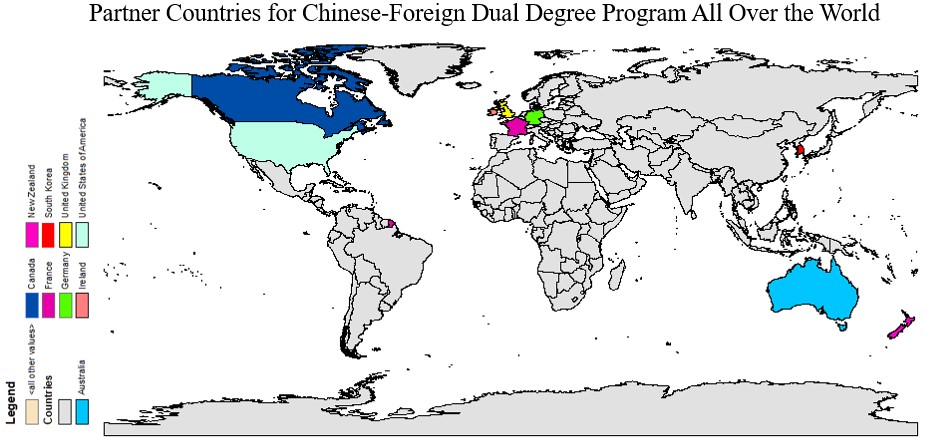Chinese-Foreign Dual Degree Education Programs: Problems and Developments
Abstract
This study researches the current status, problems, and development countermeasures of Chinese-foreign dual degree programs in Chinese higher education by using Microsoft Excel and geographic system information (GIS) software, including their types of degree, geographical distribution, and collaborative partners. The result shows a reasonable reginal distribution of Chinese-foreign dual degree program in higher education is a strong guarantee to promote the coordinated development of higher education. How to establish a common quality guarantee system and make the cooperation certificate-oriented is also need to further research.
References
Amin, R., Iqbal, M. M., Hussain, M., Iqbal, Z., & Saleem, N. (2016). A cloud based GIS application framework to analyze road accidents using windows azure. International Journal of Computer Science and Information Security, 14(1), 38.
Chang, Y., & Park, H. (2006). XML web service-based development model for internet GIS applications. International Journal of Geographical Information Science, 20(4), 371-399. https://doi.org/10.1080/13658810600607857
Culver, S. M., Puri, I. K., Spinelli, G., DePauw, K. P. K., & Dooley, J. E. (2012 & 2011). Collaborative dual-degree programs and value added for students: Lessons learned through the evaluate-E project. Journal of Studies in International Education, 16(1), 40-61. https://doi.org/10.1177/1028315311403934
Huang, J. R., & Zhang, C. Y. (2008). Analysis of strategy for transnational education quality assurance in Australia. Higher Education Exploration, 6, 70-73. Chinese Press.
Knight, J. (2011). Doubts and dilemmas with double degree programs. RUSC. Universities and Knowledge Society Journal, 8(2), 135. https://doi.org/10.7238/rusc.v8i2.1067
Lin, J. H., & Liu, M. G. (2013). On the quality construction of Chinese-foreign cooperation in school running. Educational Research, 10, 72-79. Chinese Press.
Moulton, B. (2011). Double degree: research pathways, enabling cross-disciplinarily and enhancing international competitiveness. Retrieved from http://www.arneia.edu.au/project/39
Obst, K., & Banks (2011). Joint and double degree programs in the global context: Report on an international survey. Institute of international education. Retrieved from http://www.iie.org/Research-and-Publications/Publications-and-Reports/IIE-Bookstore/Joint-Degree-Survey-Report-2011#.V9v0rXnrsdU
Singh, A., Noor, S., Chitra, R., Gupta, M., & Vel, N. K. (2015). GIS applications in geotechnical engineering - some case studies. International Journal of Latest Trends in Engineering and Technology, 5(2)
State Council. (1993). Outline for Education Reform and Development in China. Beijing: People’s Education Press. Chinese Press.
Tan, S. H. (1994). Research on the Development Strategies of Higher Education in China. China Higher Education Research, 2, 24-30. Chinese Press.
Tomic, M. (2014). The use of methods of remote sensing and GIS applications in monitoring water quality on the example of the mining basin. Geonauka, 2(1), 1-8. https://doi.org/10.14438/gn.2013.25
Villa, B., & Scianna, A. (2011). GIS applications in archaeology. Archeologia e Calcolatori, (22), 337-363.
Wang, P. G., Hu, S. H., Wang, L., & Wu, S. M. (1996). Pattern research for Chinese-foreign cooperative education. University Education Science, 1, 13-16. Chinese Press.
Ye, L. (2012). Quality assurance of transnational degree program. Zhejiang University Press. Zhejing. In Chinese.
Young, M., Pierce, F. J. D., & Clay (2008). GIS applications in agriculture. Experimental Agriculture, 44(2), 273. https://doi.org/10.1017/S0014479708006248
Zhang, J. P., & Liu, S. X. (2013). Study of current of double degree programs run jointly by Chinese and foreign higher education. Journal of Graduate Education, 5, p.21. Chinese Press.
Zhang, J. P. (2013). Research on the transnational double degree programs (Doctoral dissertation). Chinese Press. Retrieved from http://www.cnki.net/KCMS/detail/detail.aspx?QueryID=2&CurRec=1&recid=&filename= 1015807883.nh&dbname=CDFDLAST2016&dbcode=CDFD&pr=&urlid=&yx=&v=MzE0NjFYMUx1eFlTN0RoMVQzcVRyV00xRnJDVVJMeWZidWRxRkNqblVMek1WRjI2Rzd1NEdkbkVySkViUElSOGU
Zhang, M. X. (2009). New era, new policy. Chinese Education & Society, 42(4), 23-40. https://doi.org/10.2753/CED1061-1932420402
Zhang, X. M. (2009). The construction and operation of Chinese-foreign cooperation in running schools system. Beijing, Higher education press.


This work is licensed under a Creative Commons Attribution 4.0 International License.
Copyright for this article is retained by the author(s), with first publication rights granted to the journal.
This is an open-access article distributed under the terms and conditions of the Creative Commons Attribution license (http://creativecommons.org/licenses/by/4.0/).









1.png)














